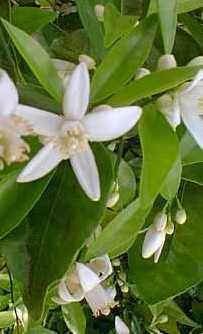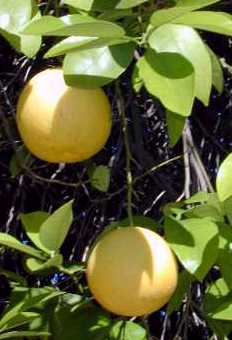by Philippe Faucon ©2003
This calendar is specially adapted to Phoenix, but probably applicable to many other climates. Here we choose to fertilize 3 times a year, which is a convenient way to do it. Citrus fertilizer with coated pellets release their nutrient more gradually, and are particularly well adapted to this frequence. If your citrus is growing in a pot, you might want to fertilize it more often, up to every 6 weeks in the growing period from February to September.

![]() January
January
This month is the
coldest of the year. Stay on the lookout, and pay attention to the
freeze warnings. You can then decide if you want to protect your
trees. Young trees, should be protected, particularly for the
sensitive species (limes, citron...).
While citrus trees are mostly dormant, they still need some water. They are generally shedding some leaves, getting ready for the new growth, this is normal.
All the fruits are all ripe, enjoy!
![]() February
February
This is the time to fertilize. Expect
more frost until the middle of the month, and occasionally until even
later.
The trees are getting ready to start growing buds. Depending on the species, they can be early or late in the month. Most species start blooming late February or early March. Water once or twice this month.
![]() March
March
Damaging frosts are not expected anymore. The
trees are showing up a lots of new buds and growth. It is a good
time to remove any frost damaged or dead area, or do some pruning for a
misplaced branch or sucker. Start thinking about painting the
exposed areas to prevent sunburn. The bark is very sensitive to
sunburn, and no part should be exposed to direct sun.
Now is also a good time to plant 5-gallon citrus.
Water deeply once this month.

![]() April
April
Remove any citrus you did not
eat, since they fall from the tree. If you still have grapefruit on the
tree, you might decide not to pick them up, they keep on getting sweeter
until the summer.
It is still a good time to plant citrus. Check that all the trunk parts of citrus and young trees that are exposed to the sun are painted white. This keeps them cooler and protects them from sunburn. Use white latex paint diluted with water (1 volume white flat latex paint for 1 volume water).
The dry air and warmth mean that you need to increase watering to every two weeks.
![]() May
May
Keep on increasing watering, once a week is a
good rhythm for established tree when the weather is hot. The leaves
curl up if the tree is stressed by the lack of water.
After some of the newly set fruits drop, you can fertilize the tree. If the tree is still small, consider removing more of the small fruit to avoid exhausting it. Citrus tree generally drop the excess fruit by themselves. You might need to treat if caterpillars attack the leaves.
![]() June
June
Water deeply once a week or more. Some mulch will keep the roots cooler and conserve water. There are disagreements on how useful mulch is for citrus. I generally put less than an inch, this helps avoiding the crust that sometimes form at the top of the dirt. In any case, almost everyone agrees that you should keep the mulch away from the trunk.
![]() July
July
Water deeply once a week or more. Some mulch will keep the roots cooler and conserve water. Keep the mulch away from the trunk.
Keep on the lookout for signs of sunburn, and paint any part of the trunk that is exposed to direct sun.

![]() August
August
Time to fertilize
again. This will help to have bigger fruit for many of the trees,
and might help new growth that should come when the weather gets
cooler. Water deeply once a week or more. Too much water can result
in chlorosis.
![]() September
September
The weather is cooling down, but the monsoon
is finished, water needs are still high. Planting is not as hard on the
plants if you wait until the night temperature falls in the 70's to do
your plantings.
You can now start decreasing the watering
frequency.
![]() October
October
The weather is cooling down, that's now that
you want to plant citrus. Don't fertilize any more to avoid starting
new growth that might freeze.
Water less often.
The fruits start showing some color as they are exposed to cooler night temperatures. The color of the citrus does not indicate ripeness.
If the fruit has been damaged by heat or lack of water, it might split.
![]() November
November
- Get ready for freeze warnings that can
happen any time from the very end of November until late February.
Slow down the watering to once every 3 weeks, or once a month. Start getting ready to protect the young trees on frosty nights. You might want to consider wrapping protection around the trunk of your young trees. Early-ripening fruit might be ready to pick.
![]() December
December
Continue picking fruit. Watch for freezing
nights. Fruit on the ouside of the tree is more exposed to frost and
should be picked first.
|
Desert Tropicals Home Page List of All the Plants /b> Desert-Tropicals is dedicated to provide gardening advice, gardening ideas, and information about flower of all kind for landscape and collections.We try to check carefully the identification of the plants on the illustrations as well as the other information from the page, but occasionally errors do occur. if you notice anything that needs to be changed please contact us.Thanks. © 1998-2020 Philippe Faucon, All Rights Reserved. |